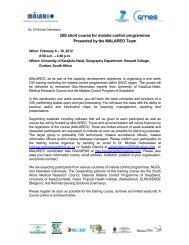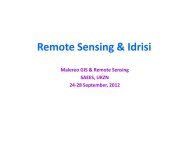Practical Manual - Malareo
Practical Manual - Malareo
Practical Manual - Malareo
Create successful ePaper yourself
Turn your PDF publications into a flip-book with our unique Google optimized e-Paper software.
<strong>Practical</strong> 7 Mapping Malaria<br />
Outline<br />
Introduction<br />
Managing Disease Data<br />
Incidence vs Prevalence<br />
Thematic Mapping of Prevalence<br />
Interpolation of Prevalence<br />
Introduction<br />
Malaria is a vector borne disease, and is one of the largest killers in Africa. It is carried by the anopheles<br />
mosquito which is mobile. While their lifespan is limited and their flight ranges limited the sheer number<br />
of mosquitoes make a significant impact. While mosquitoes feed primarily on nectar, they require the<br />
iron and protein from blood in order to procreate. The Female transmits the malaria virus when she<br />
inserts her proboscis through the skin and injects an anti-coagulant into the victim to allow her to suck<br />
blood from the bite site.<br />
In order to target and combat Malaria, one needs to identify where the disease is located. The<br />
distribution of Malaria changes with time, primarily due to the presence or absence of mosquitoes.<br />
Hence in winter (Drier months) there is less malaria due to fewer mosquitoes. Therefore to adequately<br />
map the disease an understanding of the presence of the vector is required.<br />
The most common means of identifying where the highest prevalence of malaria is located is obtained<br />
from medical records where cases of malaria are treated. This can locate where the case was<br />
contracted, giving a general area where the disease is commonly found GIS is a useful means of mapping<br />
the presence and absence of a disease.<br />
The study of diseases is known as epidemiology. There are numerous methods of determining risk and<br />
distribution of disease You will look at a number of statistically based methods to show where malaria is<br />
located.<br />
John Snow is widely regarded as the father of Epidemiology, when he used the presence of cholera<br />
cases to pinpoint the source of the infection in London, tying it to dirty water from a pump.<br />
In essence you will be undertaking a similar exercise.<br />
QGIS for Malaria Page 56




